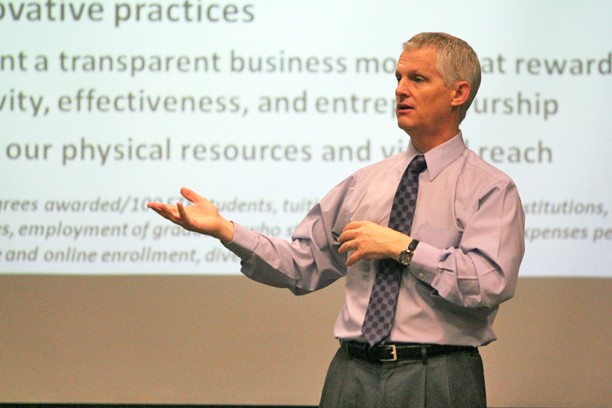Three years after implementing a new university-wide budget model, called Responsibility Centered Management, the University of Arizona has convened a committee to review the model and recommend improvements and adjustments to UA President Dr. Robert Robbins.
Just as RCM impacted students’ UA experience when it was first implemented, any changes now have the potential to reverberate across the whole university.
“Over the course of the academic year, we are going to take a look at RCM and make sure we understand what is really working well and identify what little things have to be fixed,” said Provost Andrew Comrie, who co-chairs the committee with Chief Financial Officer Gregg Goldman.
The first three years of RCM were designed as a pilot test for the UA; no changes were made and a review was guaranteed.
“It is our budget system and we need to make sure it works for us,” Comrie said.
At its core, RCM determines how the university’s revenue is distributed — everything from students’ tuition and fees to state allocations and philanthropic donations.
RELATED: Regents approve capital development plan, discuss tuition policies
Previously, the university budget functioned loosely like a command economy with the administration distributing blocks of funding. Those with the loudest voices often received the most money, sometimes to the detriment of students.
RCM aimed to bring transparency and equity to the budget by awarding funding based on the activity of “units” or colleges in terms of teaching, research, facilities costs and more. This activity model incentivizes strategic investments and encourages an entrepreneurial spirit, according to Comrie.
“RCM encourages colleges to manage all their revenues and costs to optimize their activities to serve our core mission of teaching students, creating new knowledge and extending that knowledge for community impact,” Comrie said.
While RCM has steered colleges toward providing a wider array of general education courses and creating exciting, effective programs to retain students, it has also resulted in some unforeseen negative consequences.
For committee member Lynn Nadel, chair of the faculty and a regents professor emeritus in psychology, there are three core concerns about RCM on the committee’s table.
“The committee needs to address the unevenness between how colleges distribute their RCM funds, the impact of RCM on cross-college collaborations and the impacts of RCM on creating interdisciplinary courses and curriculum,” Nadel said.
RCM allows each college or unit to distribute its revenue and costs in the spirit of RCM, acknowledging no one mechanism could be most effective in both the College of Humanities and, for example, the College of Optical Sciences.
According to Nadel, some colleges adhered less strictly than others to RCM’s mission of transparency and simplicity, leading to the perception of unfairness among some faculty.
By rewarding colleges teaching more students in the classroom, RCM has expanded the sizes and numbers of once-limited general education courses. As a consequence, however, colleges and programs come into conflict over how to share RCM funding when designing curriculum and collaborating on research or more — potentially limiting new opportunities for students.
Initially, Nadel believed internal governance structures would arise to resolve these disputes. That has not been the case.
Nevertheless, Nadel believes he and his fellow committee members will be able to justify the continued use of RCM.
“RCM allows students to talk with their feet,” Nadel said.
This provides the majors students desire the resources to best serve them and encourages colleges to compete to build the most successful programs and investments instead of leveraging politics behind closed doors, like in the past, according to Nadel.
RELATED: President Robbins outlines UA’s future to regents
It is the committee’s responsibility to apply the lessons of the last three years to balance faculty concerns and fulfill RCM’s promises of transparency, simplicity and growth for the entire UA.
The committee consists of 25 members, handpicked by co-chairs Comrie and Goldman, and encompasses a wide range of university voices from college deans and student body presidents to vice presidents of student success and research.
The committee members, many of whom helped design RCM, will break into subcommittees to investigate specific aspects of RCM and enlist a further 80 to 90 UA faculty and staff’s expertise.
Comrie hopes the committee will complete its review by the end of the spring semester with any potential recommendations being implemented in UA’s new budget due this summer.
Faculty and staff are encouraged to reach out to their deans or any committee member with concerns or recommendations.
Follow Randall Eck on Twitter









